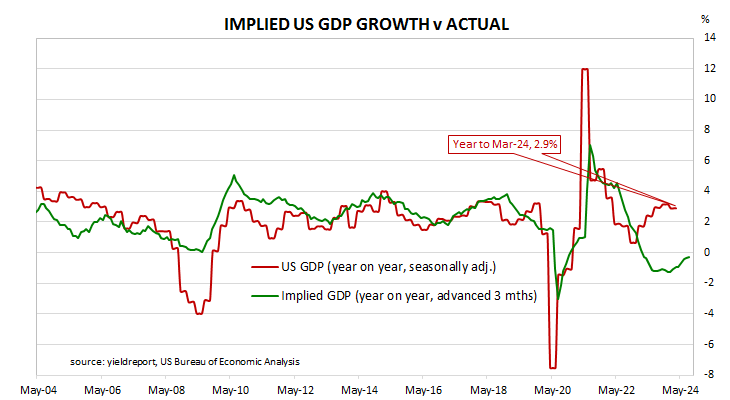Summary: Conference Board leading index down 0.5% in May, worse than expected; doesn’t currently signal recession; US Treasury yields barely change; rate-cut expectations firm slightly; regression analysis implies 0.3% contraction in year to August.
The Conference Board Leading Economic Index (LEI) is a composite index composed of ten sub-indices which are thought to be sensitive to changes in the US economy. The Conference Board describes it as an index which attempts to signal growth peaks and troughs; turning points in the index have historically occurred prior to changes in aggregate economic activity. Readings from March and April of 2020 signalled “a deep US recession” while subsequent readings indicated the US economy would recover rapidly. Readings post-2022 implied US GDP growth rates would turn negative but that has not been the case so far.
The latest reading of the LEI indicates it decreased by 0.5% in May. The fall was worse than the 0.3% decline which had been generally expected but it was a slightly better result than April’s figure of -0.6%.
“While the Index’s six-month growth rate remained firmly negative, the LEI doesn’t currently signal a recession,” said Justyna Zabinska-La Monica of The Conference Board. “We project real GDP growth will slow further to under 1% annualized over Q2 and Q3 2024, as elevated inflation and high interest rates continue to weigh on consumer spending.”
The reading came out the same day as the latest S&P Global PMIs and US Treasury bond yields barely moved. By the close of business, the 2-year Treasury yield had slipped 1bp to 4.73% while 10-year and 30-year yields both finished unchanged at 4.26% and 4.40% respectively.
In terms of US Fed policy, expectations of a lower federal funds rate in the next 12 months firmed slightly, with four 25bp cuts currently factored in. At the close of business, contracts implied the effective federal funds rate would average 5.30% in August, 3bps less than the current spot rate, 5.24% in September and 5.075% in November. June 2025 contracts implied 4.335%, 100bps less than the current rate.
Regression analysis suggests the latest reading implies a -0.3% year-on-year growth rate in August, up from -0.4% for the year-to-July growth rate.



